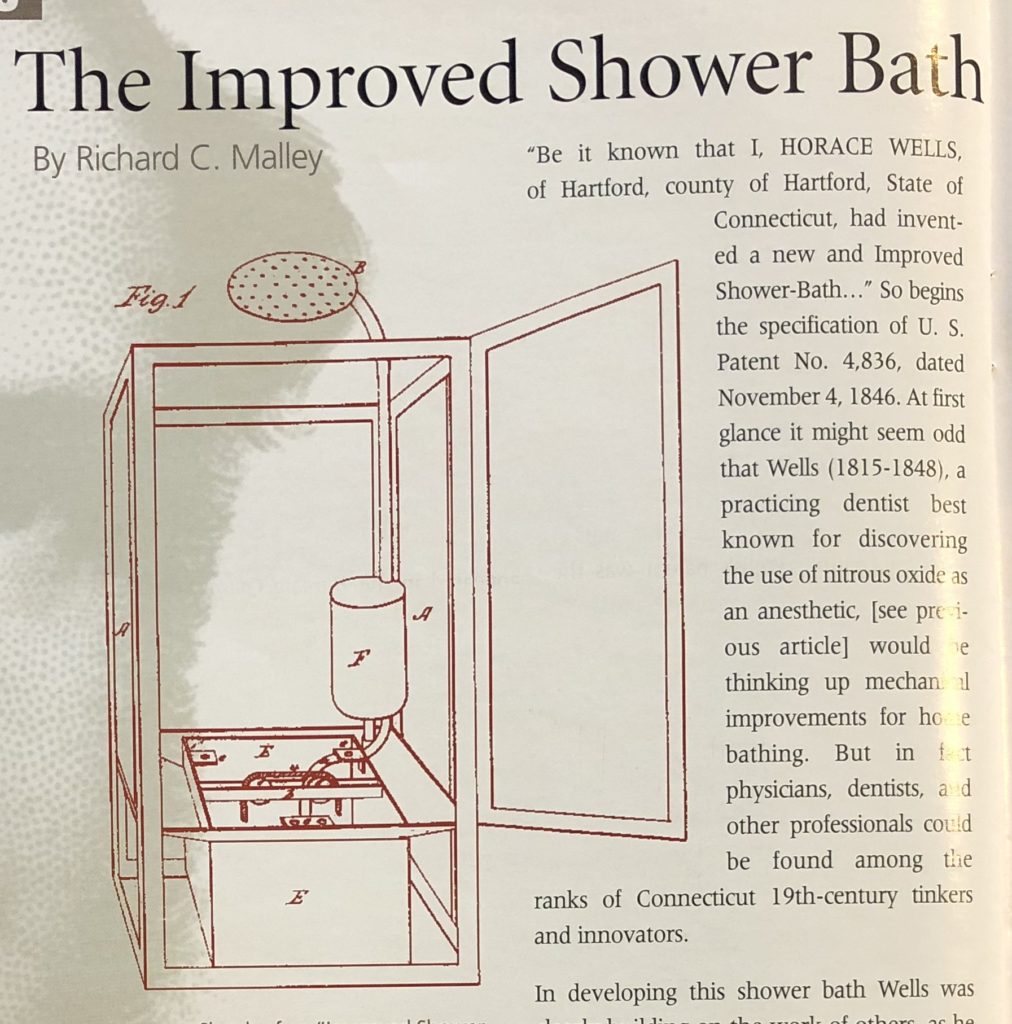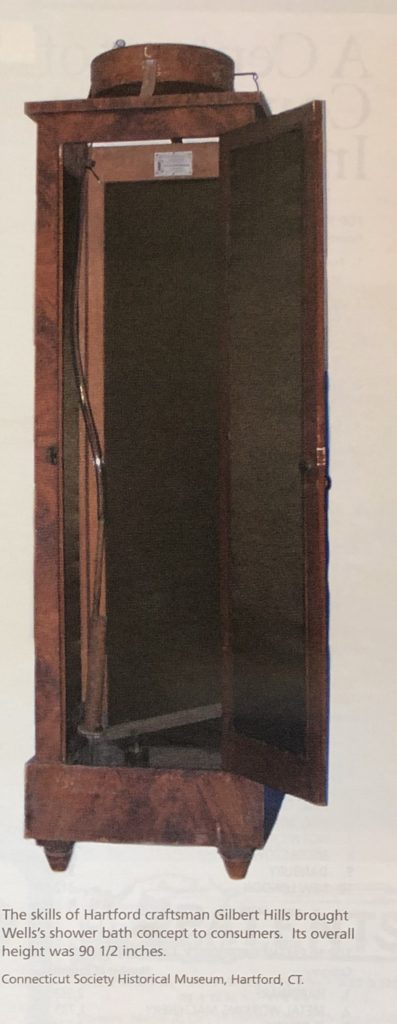
Sketch of an “Improved Shower-Bath,” which accompanied Horace Well’s patent application, May 1846.
Connecticut Historical Society Museum, Hartford
By Richard C. Malley
(c) Connecticut Explored Inc Spring 2005
Subscribe/Buy the Issue!
“Be it known that I, HORACE WELLS, of Hartford, county of Hartford, State of Connecticut, had invented a new and Improved Shower-Bath…”
So begins the specification of U.S. Patent No. 4,836, dated November 4, 1846. At first glance it might seem odd that Wells (1815-1848), a practicing dentist best known for discovering the use of nitrous oxide as an anesthetic, [see previous article]would be thinking up mechanical improvements for home bathing. But in fact physicians, dentist, and other professionals could be found among the ranks of Connecticut 19th-century tinkers and innovators.
In developing this shower bath Wells was clearly building on the work of others, as he notes in the patent letter, “I am aware that boxes for shower baths have been made similar to the one described before, therefore I do not claim the box…” What Wells was claiming was an improvement in the method of circulating water through the shower bath in a way to keep the hands free for actual washing. The secret was the treadle-powered pump that allowed water to be raised into an overhead cistern after which gravity would allow it to flow through the showerhead or, in his words “strainer or colander.” Unlike modern showers, the water would be recirculated rather than immediately drained, a fact that points up the notion that at the time soaps were used more for laundering clothes than personal washing. A tub, ostensibly of warm water, provided the initial supply, and the device was drained after use.
Wells’s work reflects an interest in promoting hygiene, both personal and public. By the beginning of the 19th century the idea of personal cleanliness was beginning to be recognized as important to both personal and public health. The lack of indoor plumbing made the practice of washing and bathing an infrequent cold-water exercise. Hence, the developments of various shower and bath schemes through the first half of the 19th century. Wells’s patent was the fifteenth issued for improvements to bathing apparatus since 1804. The fact that these are listed in the Patent Office’s category of “Class 20 – Surgical and Medical Instruments” clearly suggests that the technologies being introduced were considered primarily advances in medicine rather than household furnishings.

The skills of Hartford craftsman Gilbert Hills brought Wells’s shower bath concept to consumers. Its overall height was 90 ½ inches. Connecticut Historical Society Museum, Hartford
Any good design requires more than an idea; it needs someone able to translate the idea into a viable product. Wells clearly understood this, as he prefaced his description of the shower bath with the statement “To enable others skilled in the art to make and use my invention… .” Just such a man was Gilbert Hills, a 27-year-old from East Hartford who operated a tinsmith shop on lower State Street in Hartford. According to an attached label Hills both manufactured and retailed this shower bath. It seems likely that he modified the design by providing for a tin holding tank above the shower head which would be activated by pulling a chain linked to a drain plug, a linkage not unlike that found in modern toilet valves. The manufacturer of the 83-inch-tall wooden shower stall, with its fashionable Empire styling and rosewood faux grain surface, is unknown.
Just how much personal collaboration existed between Wells and Hills is unknown. Horace Wells moved to New York City in 1847 where, severely depressed over his perceived failures, he committed suicide in January 1848. Gilbert Hills continued to work as a tinsmith and manufacturer of the shower bath until the spring of 1849 when, apparently succumbing to gold rush fever, he sailed on May 21, 1849 from New York aboard the bark Alice Tarltan, bound for adventure in the California gold fields. It is unclear whether he ever reached the gold fields, as evidenced by the following obituary which appeared in the Hartford Courant on June 13, 1850: “At San Francisco, April 21, of dysentery, Mr. Gilbert Hills, late of this city, aged 29.”
Are We Clean Yet?, a lighthearted look at the pursuit of cleanliness in Connecticut over two centuries, is currently on view at The Connecticut Historical Society Museum in Hartford. The exhibition includes an example of the shower bath devised by Wells and manufactured by Hills. While some of the piping is missing and the original horsehair curtains have been replaced with more modern fabric, the essential design features inherent in Wells’s patent are clearly visible.
Richard C. Malley is curator of technology at the Connecticut Historical Society Museum. He last wrote about the Pope-manufactured Columbia Woman’s Safety Bicycle in the Spring 2003 issue.
